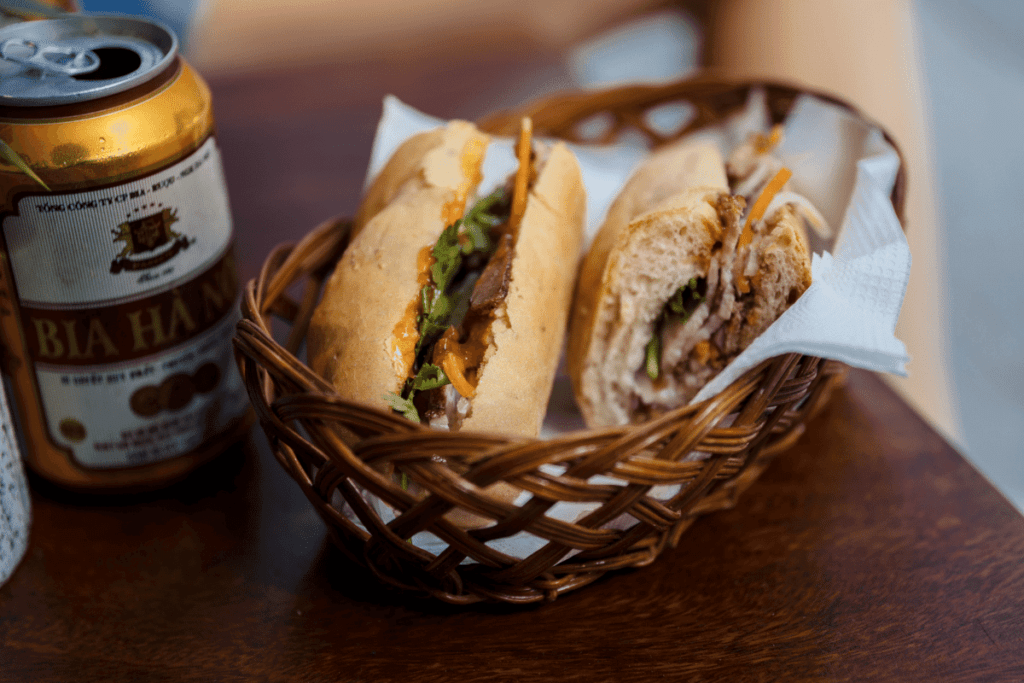
Alright, all you foodies out there: this one’s for you! When it comes to international cuisine, Vietnam and Cambodia are a must. With intense flavors, fresh ingredients, and vibrant colors, these two countries are a food lover’s paradise. Here are five typical dishes in Vietnam and Cambodia to try during your next adventure east.
Here’s how to stay smart when sampling all the oh-so-delicious street foods during your international travels (and what to do if things start to…well…go south!).
1. Banh Mi
Step aside, pho! We must admit the banh mi is our most favorite of the typical dishes in Vietnam. Pronounced “bon mee,” the name literally means “bread” or “baguette,” from bánh (cake or pastry) + mì (wheat).
How did this little sandwich become one of the most typical dishes of Vietnam? Let’s start by answering the question: how did the baguette make it to Vietnam?
A Little History of the Banh Mi
The banh mi is an amazing symbol of national resilience. During the French colonization of Vietnam from 1887 to 1954, the French introduced specific crops and livestock into Vietnam that would supply them with their traditional foods of meat, cheese, coffee, and bread. The French prohibited Vietnamese people from consuming them—not that the locals could afford them anyway, as the imports were incredibly expensive.
After the French left Vietnam in 1954, the Vietnamese began tweaking the French bread tradition in order to fit local tastes (and make it more affordable!). They added more yeast and water to the baguette to make it lighter, and they spread mayo and pork liver on their bread rather than the French traditions of butter and goose liver.
The first banh mi made its appearance in the late 1950s at a snack bar in Ho Chi Minh City. It gained swift popularity for its portability and affordability, and it wasn’t long before every region of the country had its own take on the sandwich. (In other words, you should definitely grab one in Hanoi’s Old Quarter on your Vietnam & Cambodia Yoga Adventure with The Travel Yogi!)
ANatomy of a Bahn Mi
crusty french baguette • cuts of meat • pickled carrots • cilantro • cucumber • seasonal vegetables • sauce
2. Cà phê sữa đá (Iced Coffee)
You’ll be on top of the world after just a few sips of Vietnamese iced coffee, one of the most typical dishes of Vietnam. The recipe goes like this: brew finely ground Robusta coffee beans through a French drip filter into a cup with half the amount of sweetened condensed milk. Stir together, then pour over ice. Voilà!
So, what’s Robusta Coffee? You’re probably familiar with arabica coffee, which accounts for 60% of the world’s coffee consumption. Robusta, on the other hand, is notoriously bitter and used for instant coffee, espresso, and filler for blends. Vietnam is the second-largest producer of Robusta coffee beans worldwide.
Vietnamese coffee beans are known for their bitterness, which is what makes their traditional iced coffee so delicious: the bitterness of the beans is cut by the intense sweetness of the condensed milk. Meanwhile, the melting ice allows both flavors to get even more fantastic the longer it sits on your table! (If you can restrain yourself long enough, that is…)
Anatomy of a Vietnamese Iced Coffee
Robusta coffee • sweetened condensed milk • ice
3. Bánh Bột Lọc (Hue Tapioca Dumplings)
Your tour of the most typical dishes of Vietnam would not be complete without these little bites of deliciousness (like, soooo delicious). Named for the tapioca flour used to make them, these dumplings are iconic for their translucent exterior, which showcases the bright red-orange shrimp and pork mixture inside. The bright color comes from the caramelized sugar that the mixture is sauteed in before being tucked into the dough (and maybe a little food coloring mixed in!). Topped with fried shallots and a sweet chili fish sauce, they make the perfect lunchtime treat.
You’ll find these dumplings in Hue, the former imperial capital of Vietnam, famous for its amazing cuisine. Try them out at one of our favorite spots: the Ba Do Restaurant.
Anatomy of Hue Tapioca Dumplings
tapioca dough • diced pork belly + shrimp sauteed in sugar + spices • onion • red chili • scallions • fish sauce • fried shallots
4. Phở
When it comes to typical dishes of Vietnam, we cannot forget phở. This noodle soup is just like its name: simple to the eye yet complex in the mouth. And, let’s solve the pronunciation question once and for all: it’s “fuh.” (Duh!) (BONUS: Watch this video for a complete breakdown of the word!)
While the term “phở” refers to the soup’s white rice flour noodles, the true test of phở greatness is the broth. Phở broth, which can include anywhere from 10 to 15 ingredients, should be clear with two nuances: meat (either beef or chicken) and spices (cinnamon, star anise, cloves, and cardamom).
Anatomy of Hue Tapioca Dumplings
tapioca dough • diced pork belly + shrimp sauteed in sugar + spices • onion • red chili • scallions • fish sauce • fried shallots
Why Phở Is the Ultimate Yogi Experience
If you’ve had phở before, you know half the fun is throwing fresh herbs and vegetables into your bowl: just the right amount of Thai basil, a handful of bean sprouts, and maybe a few jalapeños (if you want a kick!).
But wait! Before you go crazy over coriander, be sure to sip the broth in its pure form first. Invoke your yogi mindset and appreciate the time that went into preparing this divine liquid, its depth and complexity… and trust in its gut-healing, soul-soothing powers!
Pro Tip
Now that you know the broth is key, #eatlikealocal and try to avoid adding distracting flavors like Hoisin, sriracha, and fish sauce to your phở (common condiments offered at Vietnamese restaurants in the U.S., but less common in Vietnam!).
5. Amok
Finally, let’s take a peek at the wonderful cuisine of Cambodia. Cambodian food traditions are a medley of flavors, with hints of Thai, Vietnamese, and French influence. Their most famous dish is amok, a curried fish stew served in banana leaves. (Say what?!)
Anatomy of Amok
white fish • lemongrass • kaffir lime leaves • coconut cream • fish sauce • palm sugar • turmeric paste • chilies • banana leaves
Amok can be found in luxury and affordable restaurants alike. You’ll know you’ve found the real deal by the stew’s custard-like consistency, which comes from steaming the fish inside the banana leaves until it flakes right off the bone. Yum! The stew makes for a light and irresistible treat as you wander through the street markets of Cambodia on your free afternoon.
Ready to Try Your Hand At Cambodian Cuisine?
Check out the cookbook From Spiders to Water Lilies: Creative Cambodian Cooking With Friends by Gustav Auer, one of the few places you’ll find written Cambodian recipes.
Finally… There’s Nothing Like a Home-Cooked Meal
No matter where you travel, there’s nothing like sharing a meal with a local family. Given the warm hospitality of the Vietnamese people, you’ll likely get invited (more than once!) to join them for dinner. Say yes! It will be the best decision you make all day. Be prepared for communal eating—a.k.a. “family-style”—where you’ll be given a small bowl of rice and share everything else with your table.
All About Balance
As a people of tradition, the Vietnamese aim to strike a balance in all aspects of life, including the culinary experience. Taste, nutrients, and presentation are all taken into account, balancing sweet with sour, hot spices with cold meats, bitter with tangy—all while creating a palette of color on the plate. Holiday meals are especially important, where every plate, bowl, and color on the table counts.
Your Food Coma Awaits
Are you salivating yet?? Join us on our next travel yoga adventure to Vietnam and Cambodia. Check out bustling capital cities, meet Buddhist monks, take a bike tour around temples, cruise through Ha Long Bay, and even take a Vespa through ancient towns—all while eating the best food of your life! Learn more or book your reservation.

